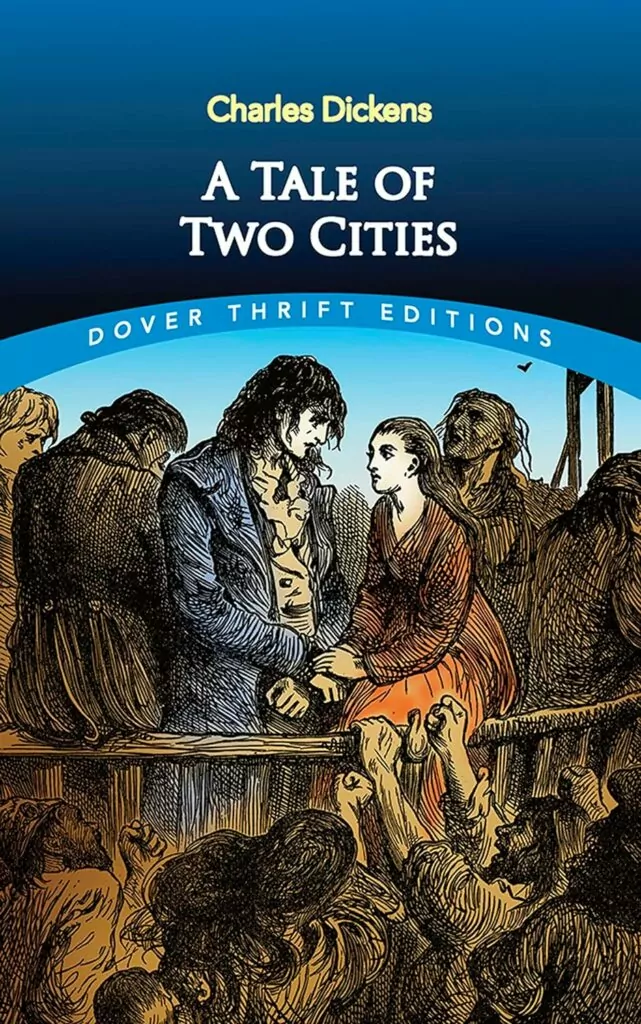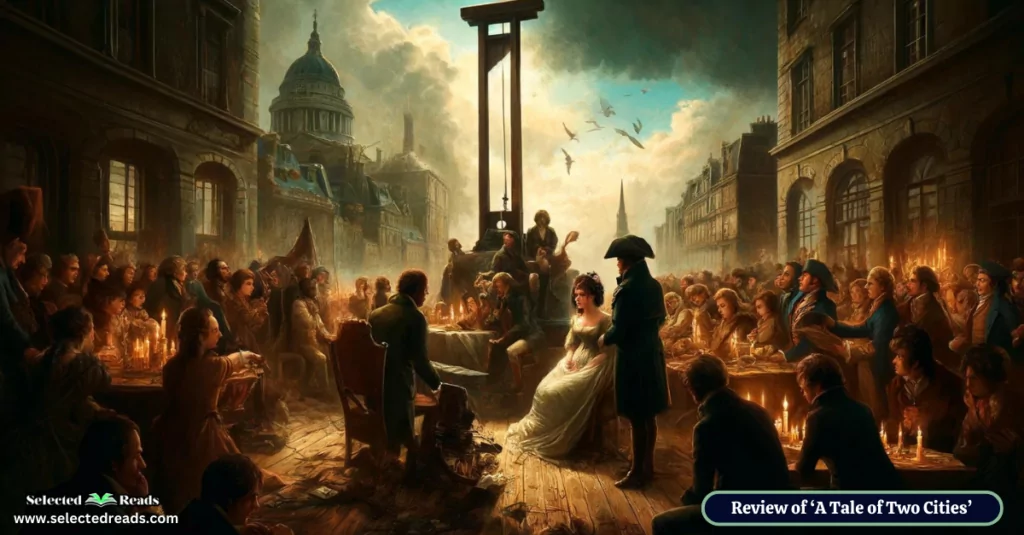Today, I’ve got a real treat for enthusiasts of historical fiction and timeless narratives: “A Tale of Two Cities” by Charles Dickens. This post aims to give you a closer look at this monumental piece of literature, ensuring you get a good grasp of its essence and themes without giving away any pivotal plot points. In my discussion, I’ll delve into the captivating world Dickens creates, exploring the profound duality and rich tapestry of characters that make this novel not just a story, but an experience.
A Tale of Two Cities Summary
“A Tale of Two Cities” by Charles Dickens is a profound narrative set within the context of the French Revolution. It weaves a complex story of love, sacrifice, and redemption across two cities: London and Paris. The novel opens with the famous lines, “It was the best of times, it was the worst of times,” setting the stage for a story that explores the contrasts of human nature and society during a time of extreme upheaval.
The story begins with the release of Dr. Alexandre Manette from the Bastille after an unjust 18-year imprisonment. He is reunited with his daughter Lucie, whom he has not seen since she was a baby. Lucie, a personification of compassion and virtue, becomes a pillar of strength for her father as they attempt to rebuild their lives in England.
Enter Charles Darnay, a young French aristocrat who renounces his heritage due to the cruelty of his family towards the French peasantry. He moves to England, where he falls in love with Lucie and eventually marries her, forming a tight-knit family circle that includes Dr. Manette, Mr. Lorry (a family friend), and the loyal Miss Pross.
Contrasting Darnay’s nobility is Sydney Carton, a brilliant but dissipated English lawyer who initially leads a life of indolence and alcoholism. Despite his outward cynicism, Carton harbors a deep love for Lucie, a love so profound that it eventually leads to his self-sacrifice.
Photograph: Amazon
The tranquility of their lives in England is contrasted with the escalating chaos in France, where the Revolution turns increasingly violent, leading to the Reign of Terror. Darnay, despite his previous renunciation, returns to France in an attempt to save an imprisoned family servant, only to be captured himself under the accusations of being an aristocrat and traitor to the Revolution.
The climax of the novel revolves around a daring plan to save Darnay from execution by the guillotine. Sydney Carton, in a remarkable act of heroism and self-sacrifice, exploits his resemblance to Darnay to switch places with him, ensuring that Lucie, the woman he loves, will have a future with her husband and family.
Dickens concludes the novel with Carton’s prophetic vision of the future, one filled with hope for Lucie’s family and a better world. His famous last words, “It is a far, far better thing that I do, than I have ever done; it is a far, far better rest that I go to than I have ever known,” encapsulate the theme of redemption that runs through the narrative.
Related: Number The Stars Book Summary
A Tale of Two Cities Characters
“A Tale of Two Cities” is rich with a variety of memorable characters, each contributing to the depth and complexity of the story. Here are the primary characters and a brief overview of their roles:
- Dr. Alexandre Manette: Once a prisoner in the Bastille for 18 years, his unjust imprisonment is the catalyst for much of the novel’s action. His reunion with his daughter Lucie and his struggle to overcome his traumatic past are central themes.
- Lucie Manette: The compassionate and loving daughter of Dr. Manette, she embodies the novel’s themes of love and sacrifice. Her marriage to Charles Darnay intertwines the fates of the characters.
- Charles Darnay (Charles Evrémonde): A French aristocrat who renounces his family’s name and moves to England due to his disdain for the aristocracy’s cruel treatment of the peasantry. He marries Lucie Manette and faces mortal peril during the Revolution.
- Sydney Carton: A dissolute but brilliant English lawyer who harbors unrequited love for Lucie Manette. His complex character arc, from cynicism to heroic self-sacrifice, provides one of the novel’s most memorable and emotional climaxes.
- Jarvis Lorry: A loyal friend to the Manette family and a banker at Tellson’s Bank. He is a stable and trustworthy figure who aids in Dr. Manette’s return to England and supports the family through their trials.
- Miss Pross: Lucie Manette’s devoted servant and protector, her strength and loyalty play a crucial role in the safety of the Manette family, especially during the climactic events in Paris.
- Monsieur and Madame Defarge: Leaders of the revolutionary movement in Saint Antoine, Paris. Madame Defarge, known for her knitting registry of enemies of the Revolution, is particularly vengeful and plays a significant antagonistic role. Monsieur Defarge was once Dr. Manette’s servant and shows some compassion towards him, but he is deeply committed to the revolutionary cause.
- The Marquis St. Evrémonde: Charles Darnay’s uncle, he represents the worst of the French aristocracy—cruel, indifferent, and arrogant. His actions indirectly set much of the plot in motion, and his murder signifies the beginning of the novel’s deeper engagement with the Revolution.
- Ernest Defarge: Husband to Madame Defarge and a former servant of Dr. Manette, he is a leader among the revolutionaries. Although he shows some early compassion for Dr. Manette, his loyalty to the Revolution’s cause makes him a formidable figure.
- The Vengeance: A companion of Madame Defarge, known for her fervor in supporting the Revolution, particularly in its most violent excesses.
A Tale of Two Cities Book Club Questions
For your book club discussion on “A Tale of Two Cities” by Charles Dickens, here are some thought-provoking questions to get the conversation started:
- What are the effects of the novel’s opening line, “It was the best of times, it was the worst of times,” on your perception of the story? How does this duality reflect the themes of the book?
- Discuss the character of Sydney Carton. In what ways does he evolve throughout the novel, and what do you think motivates his ultimate sacrifice?
- Explore the significance of doubles and parallels in the novel, such as Charles Darnay and Sydney Carton, London and Paris, or the themes of resurrection and revolution. How do these dualities enhance the story?
- Examine the role of women in “A Tale of Two Cities.” How do characters like Lucie Manette and Madame Defarge represent different aspects of femininity or societal roles?
- The French Revolution serves as a backdrop for much of the novel. How does Dickens portray the Revolution, and what commentary is he making on its causes and effects?
- Discuss the theme of resurrection in the novel. How is this theme depicted through the characters and events?
- Charles Dickens uses a variety of settings to tell the story, from the streets of Paris to the quiet life in London. How do these settings influence the narrative or the characters’ fates?
- How does the concept of sacrifice play out in the novel? Consider the sacrifices made by various characters and discuss their significance to the overall story.
- Examine Dickens’ critique of social injustice. How are issues of class and inequality addressed in the novel, and how do they drive the plot forward?
- The character of Madame Defarge is often seen as a symbol of the Revolution’s excesses. Discuss her motivations and the impact of her actions on the plot and other characters.
- Discuss the use of foreshadowing in the novel. How does Dickens use this literary device to build tension or prepare the reader for future events?
- How does the novel address the theme of revenge? Consider the characters of Madame Defarge and the Marquis St. Evrémonde in your discussion.
- In what ways is “A Tale of Two Cities” a historical novel, and in what ways does it transcend its historical setting to address universal themes?
- Discuss the ending of the novel. Were you satisfied with the resolution of the characters’ stories? How does the ending reflect the novel’s themes?
Related: The Grapes of Wrath Summary
Final thoughts
In wrapping up, I trust this brief overview has sparked your interest in “A Tale of Two Cities.” This novel is nothing short of a masterpiece, weaving together intricate themes and unforgettable characters. If it hasn’t yet made your reading list, I strongly encourage you to dive into its pages. Discover for yourself why this tale remains a beloved classic across generations.









